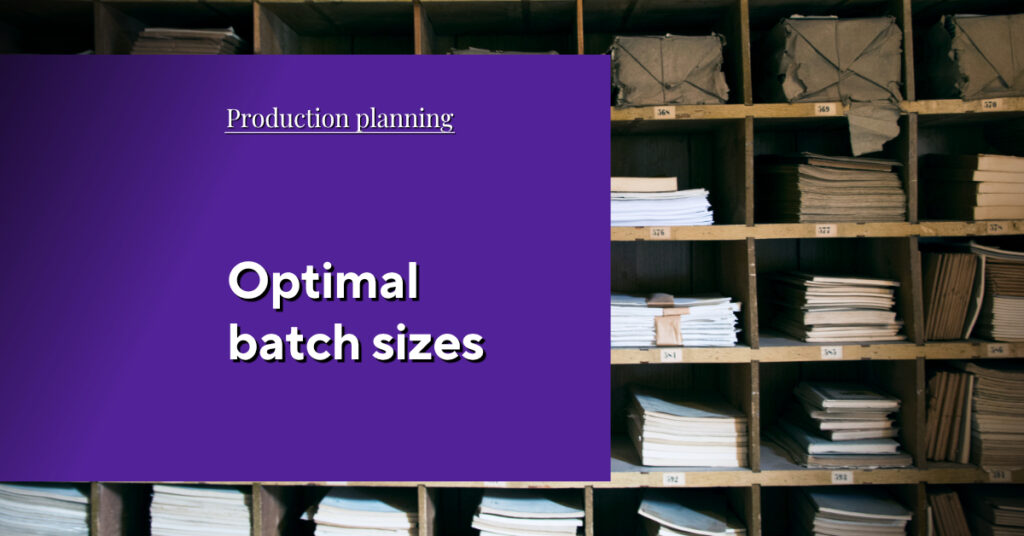Free up capital
with optimal
inventory
The last few years have seen a lot of discussion about vulnerable supply chains. International supply chains have been under immense pressure. There has been a lot of talk about vulnerable supply chains in recent years. During the coronavirus pandemic, lockdowns and border closures put international supply chains under enormous pressure. Several geo-political crises and wars have made supply chains increasingly vulnerable, forcing companies to take action to keep production going. (To learn how mathematical optimization can help companies strengthen the resilience of their supply chains, read our article Supply Chain Resilience – here to stay).
One counter-measure taken by many companies has been to increase safety stocks. Yet this has now created new challenges. In this article, we will explain what these challenges are and how these can be counteracted and even prevented by applying mathematical optimization.
Vulnerable supply chains mean full warehouses
Volatile supply chains were, and still are, a major problem for the manufacturing industry. As a result, full warehouses have made a comeback: By having more materials and goods in their warehouses, companies are less dependent on functioning supply chains. However, high inventory levels tie up capital which could be used elsewhere. Not only that, capital costs are skyrocketing due to currently high interest rates which have created further problems in many companies.
Yet in many sectors, a lot of capital is needed now more than ever in order to meet the current demands and remain competitive in the long-term. The transition to renewable energy to meet defined climate targets and the automotive industry’s switch to electric cars are just two examples of the high need for investment.
So, how can capital that is tied up in stock be freed up without it jeopardizing reliable production and again exposing companies to vulnerable supply chains if the worse comes to the worst?
Storage levels vs. service level
The best solution for both requirements

Are you interested in our factsheet?
What are the benefits of mathematical optimization?
The right technology makes all the difference
Digitization, Machine Learning and optimization
The key lies primarily in the application of the right technology. With digitization, current inventory levels can be retrieved and assessed at any time. Supply chain digitization is also essential to gain an overview of probable default probabilities and redundancies and to be able to plan. It is precisely this transparency which enables the analysis of the current status and allows a company to make timely adjustments to its inventory.
Machine Learning is another form of technology which can support you in aligning your inventory with requirements. By processing historic data, algorithms can create machine learning forecasts which can make accurate predictions and generate more realistic inventory needs. (You will find more details in this article).
Based on the predicted requirements and the supply chain evaluations, mathematical optimization can calculate the required stock levels and make the appropriate adjustments to safety stock.
Thanks to these different technologies, safety stocks can be adjusted to requirements continuously, warehouses can be put to more efficient use and capital can be freed up.
More interesting articles
Free up your capital with OPTANO
Lower, but more reliable storage levels
OPTANO is an optimization software which offers you the opportunity to perform the analyses and calculations described above far more efficiently and user-friendly. In this way, you gain more supply chain certainty, your inventory is reduced to the necessary minimum while guaranteeing the service level at the same time. Capital is freed up and can be used elsewhere.
In addition, OPTANO lets you analyze the consequences of decision-making in what-if scenarios. For example, you can calculate what the impact on the service level would be if you were to lower your inventory levels. Conversely, you can also simulate how much stock is necessary and the costs that would incur – and thereby make informed decision on the trade-off between inventory costs and delivery reliability. It is also possible to realistically analyze in advance what would happen if you were to make any changes to your supply chain, such as choosing a new supplier. This helps you decide which steps you should take based on reliable data.
Would you like to reduce your inventory with the certainty that you are not putting your production at risk? We are happy to support you in the optimization of your inventory planning. Why not contact us? Together we can work out how mathematical optimization can be deployed effectively in your business.
Look to the future with confidence and optimal inventory
Supply chains will never be considered as reliable as they were several years ago. The focus is now on supply chain resilience. Warehouses have been stocked up and safety stocks increased. But more is not necessarily better! Together we can free up your capital which has been slumbering in your inventory and keep your production running at a high level.
Do you want to read our factsheet on this topic?

In our factsheet “What are the benefits of mathematical optimization?” we ask 5 questions to help you assess whether mathematical optimization brings benefits to your organization.
To obtain our factsheet, all you need to do is enter your contact details in the space below. A pop-up window will then open to download the whitepaper. Please note that by providing us with your email address, you agree that we may contact you on this topic. You may revoke this agreement at any time by contacting privacy@optano.com.






